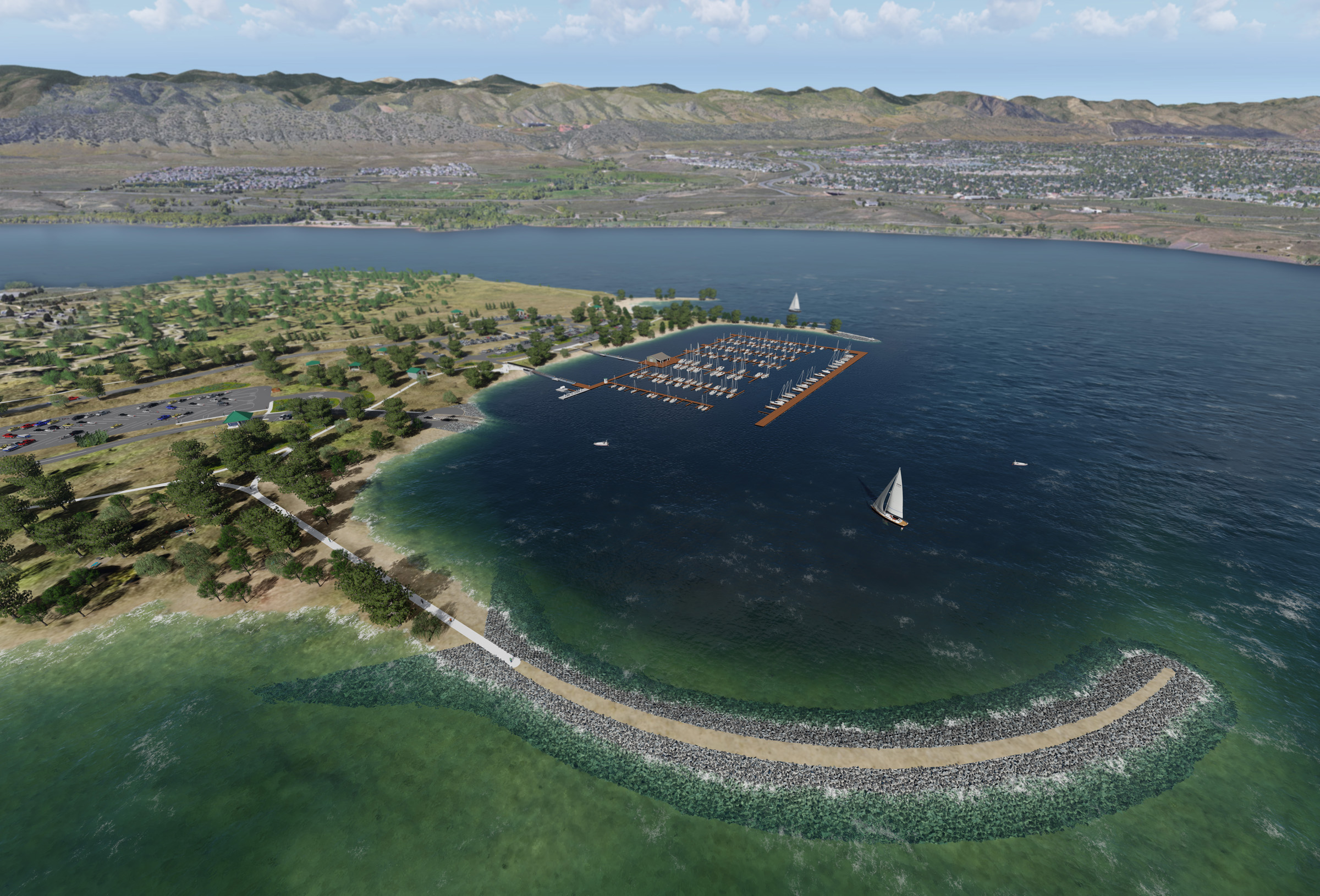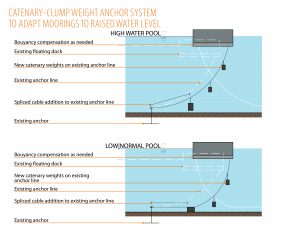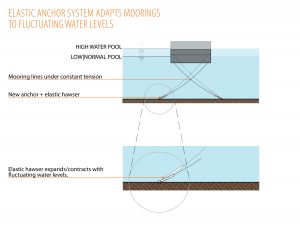
Weighing Anchors: Evaluating Options for Marinas Facing Substantial Water-Level Fluctuations
Published on May 1, 2019If asked about anchoring, chances are good that a marina engineer will think about docks before boats. Securing and stabilizing floating docks can be extremely challenging. It becomes even more challenging if the facility experiences significant seasonal or tidal water level fluctuations, or those levels change quickly during storm or flood events.
A floating dock’s adaptability or responsiveness to changing water levels requires the support of a mooring system that can accommodate those changes. That system must also be cost-effective, align with the marina’s operational capacity, and respond to the climatic factors at work along lakes, rivers and oceans. Developing and adopting a site-responsive anchoring strategy is essential for navigating the ups and downs caused by dynamic shifts in water depth.
Water-Level Dynamics
The first step is to understand what a location’s relative water depths and water-level fluctuations will require from that system. Analyzing the marina’s extremes, both high and low, and how quickly those levels can change is foundational to selecting the right solution.
Marinas located on reservoirs often experience significant seasonal changes. In addition to these routine annual rhythms, intense or prolonged rainfall events can drive water-level fluctuations in excess of 60 feet. Marinas facing an increase in tidal fluctuations, or flashy conditions due to upland runoff or storm surge, must be designed for a very different set of challenges. The fact that these conditions are projected to become more frequent or extreme due to climate shifts adds another layer of complexity that must be considered.
Even inland lakes are starting to see a more dynamic range of water level fluctuations, frequently due to upland development within the watershed or variability in ice cover. Both hindcasting and forecasting are needed to evaluate the range of influences key to selecting the most suitable mooring system.

 Operational Needs and Capacity
Operational Needs and Capacity
Like every built system, mooring systems have costs related to their installation, management, maintenance and ultimately repair and replacement.
Knowing a marina operator’s capacity to respond to dynamic conditions is just as important as knowing the conditions that the system must respond to. A higher maintenance system could be the right choice for some marinas and become an ongoing headache for operators and patrons in others. For example, cable and winch systems can require a high degree of labor to adjust in response to frequent water level variations.
Anchoring must also accommodate a dynamic range of day-to-day operational requirements. Marinas with floating buildings or floating infrastructure in addition to docks may need to consider a combination of strategies based on differential loading, freeboard expectations or stability preferences. Marinas that host deeper draft boats need to anticipate how the selected system could potentially interfere with navigation. One simple approach could be hiding lines under headwalk or finger piers.
There are four relatively common options for anchoring floating docks. While they can be applied independently, or less frequently in combination with each other to create a hybrid system, each one has its own advantages and limitations with respect to addressing water-level fluctuations.
Pile Restraint
A pile-restrained floating dock system is considered to offer the greatest amount of control over lateral movement and is similar to the level of stability offered by a fixed-dock system. Coastal dock systems are often pile-restrained due to the extreme conditions they face, dock type preference and boater expectations. While piles can be used with a variety of floating dock systems, they are a particularly good match for concrete pontoons – which benefit from the added stability piles provide.
The main limitations to pile-restrained systems are water heights and environmental considerations. For marinas that experience significant changes in water levels over the course of the year or are mandated to meet extremely improbable conditions as part of permit conditions, the required piles may be too tall to be practical or aesthetically appealing. Imagine piles standing 60 or 80 feet above average water pool levels like a sequoia forest without any greenery.
Pile installation is also seen by a number of agencies as having a significant environmental impact on a variety of aquatic species throughout a range of different seasons. Soil conditions influence pile-driving ability and embedment. Ice jacking – a process that involves ice sheets gripping onto piles and pulling them out of the ground – also plays into the decision about the suitability of piles in cold weather climates.
Chain and Anchor
This system has been around a long time, and represents a cost-effective, durable option. While anchor blocks of concrete or homemade anchors made from filled drums work, this system also works well with helical anchors, which screw in rather than rest on or near the surface of the seabed. Geotechnical considerations, in addition to the weight of docks and vessels being moored, are significant considerations when evaluating which type of anchor to use with chain.
One of the keys to its effectiveness is the length and scope (angle between the seabed and hypotenuse connection to the dock) of the chain. A chain-and-anchor system relies on the suspended weight of the chain and the resistance of its anchor for stability and to minimize the lateral dock movement. This makes relative water depth an important performance consideration. When used in shallower water, there is less chain weight, which leads to less stability in the system. It also becomes more problematic to use, the greater the difference gets between high and low water levels.
Cable and Winch
A cable-and-winch system provides flexibility to address a wider range of water level fluctuations. As water depths rise and fall, the length and tension of the lines can be manually adjusted with a winch.
Taking advantage of this flexibility can require considerably more effort from a management standpoint, so it’s important to have the staffing resources required to adjust and maintain the system. In situations where water levels can change rapidly, there will also be a need for rapid manual adjustment of the system. As force on some types of cables increase, there can be a tendency for the line to want to twist. This can be problematic with helical style anchors if appropriate swivels aren’t added, resulting in movements that ultimately can lead to the anchor twisting out like a screwdriver. This problem can be addressed by installing proper attachment hardware between the cable and anchor or by substituting an ultra-high-molecular-weight polyethylene braided rope.
Over-tensioning of lines or high water can place excess force on anchors, resulting in sliding or anchor movement, making it important that the pull angle be relatively shallow. Oftentimes, this results in anchors being placed a great distance from the dock that is being restrained. To minimize the tension on lines, pull on docks, and level of management time and effort, operators may leave extra slack in the cable lines. This means the docks tend to move around more, making live loads much more live. This looser anchoring can also make it feel awkward to walk on the docks. And while a flexible dock system can accommodate this movement if the entire system allows for it, it isn’t the best option for more rigid dock systems like concrete pontoons.
Elastic Mooring
This passive system uses stretchy cables that adapt automatically to water level fluctuations. The number and size of elastic cables depend on the loads of what’s being anchored. Much like a rubber band, elastic systems stretch to adjust to water level changes. Most systems maintain a fairly uniform downward pull or tension on the docks, making the docks uniformly stable almost regardless of water level. The cable’s combination of strength and stretch enhances its performance during storms, when its ability to absorb sudden, violent force makes it less likely to fail. In extreme conditions and before the elastic system breaks due to excessive stretching, a bypass system automatically engages and a solid cable kicks in. Anectodical evidence from discussions with marina operators and some system manufacturers suggests these elastic systems are ideal, exhibiting little failure even in extreme conditions resulting from hurricane forces.
Chatfield State Park Marina
This project demonstrates how the evaluative approaches outlined above were used to develop a unique and effective anchoring strategy for a marina facing a future of more frequent and sustained variation in water levels.
The Chatfield Reservoir, located southwest of Denver, is a U.S. Army Corps of Engineers facility that offers flood control storage and is also a water source for Denver area residents. The reservoir lies within Chatfield State Park and is a local and regional destination for boating, hiking, kayaking, fishing and other recreational uses. Due to increasing population and demand for water resources, and following an extensive regulatory and environmental review process, the reservoir is set to accommodate an additional 20,600 acre-feet of water storage.
SmithGroup worked with the Chatfield Reservoir Mitigation Company, Colorado State Parks and the marina operator to analyze the impact of additional water storage on the existing marina and nearby park facilities and to redesign both the marina and landside facilities for these new conditions.
There were concerns over the increased need for adjustments required for a cable and winch system similar to what was historically used at the marina; the mooring system also needed to meet new requirements mandating the dockage float to up to the level of the reservoir spillway 68 feet above current normal summer pool, and 85 feet above the drought pool.
The dock anchoring system for Chatfield ‘s previous marina involved manually adjusting 99 winch points throughout the marina. While adjustments were necessary during the spring and as the facility headed into winter, it required infrequent adjustments to the cable and winch system throughout the boating season. To simplify the management and provide like-kind effort to manage the facility with relatively few marina staff, the team evaluated the feasibility of elastic mooring using the Seaflex system along with more traditional options such as chain and anchor.
As the alternatives were reviewed, it became clear there was no single silver-bullet solution. The team designed a unique anchoring system using both passive and active strategies. One of the major challenges to overcome was the relatively shallow water depth that could occur within the reservoir during dry conditions. Chain-and-anchor was considered, but was discarded as the weight of the chain in shallow water wasn’t adequate for holding the docks in place. While elastic lines would accommodate the required fluctuation through the typical range of water levels, the challenges became how to reduce conflicts with boats, and how to address extreme high-water levels that couldn’t be met economically by the elastic system alone.
The first challenge was addressed by installing a pipe below the docks to just above the lakebed at low water to maximize clearance. The elastic lines and anchors were then run below the docks to maximize clear space under slips and within fairways.
The second challenge was met by adopting a hybrid system; cable and winch would be installed to manage the more extreme water conditions, while the passive elastic mooring system would address the narrower range of water level changes during the main boating season. As the limits of the Seaflex system are reached, the marina switches over to the manual cable-and-winch system. This approach met the project budget, while providing flexible anchoring capacity that extends up just past the spillway height when the winch spools are fully deployed.
As this example demonstrates, sometimes a combination of anchoring approaches represents the best solution for dealing with water-level fluctuations. Careful consideration of the environmental and operating conditions and the desired level of active versus passive response to water-level fluctuation is key to selecting the best solution.
Jason Stangland is SmithGroup’s waterfront practice director. He can be contacted at 608-327-4412 or at Jason.Stangland@smithgroup.com.
| Categories | |
| Tags |






